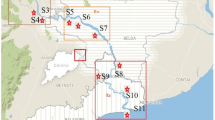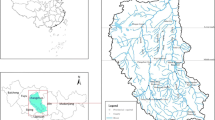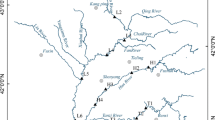Abstract
The study underscores the use of equilibrium partitioning (EqP) to determine bioavailability and the narcosis theory to estimate toxicity of PAHs to benthic invertebrates. Eight PAHs (anthracene, azuleno(2,1-b)thiophene, benz(a)anthracene, carbazole, dibenzothiophene, benz(a)azulene, dibenzo(a,h)anthracene and phenanthrene) were identified with phenanthrene and carbazole recording the highest (6.29 μg/g) and least (0.06 μg/g) concentrations at both seasons. Based on EqP and Narcosis model, the sum of PAHs toxic unit (∑TU), at both sites is ≪1, suggesting no likelihood of PAHs toxicity to benthic invertebrates. The study suggests continuous PAH monitoring especially with aquatic species due to their transfer to human via food chain.




Similar content being viewed by others
References
Aderemi OO, Olabode IA, Olalekan SF (2003) Isolation and determination of polycyclic aromatic hydrocarbons in surface runoff and sediment. Water Air Soil Pollut 147:245–261
Chen SJ, Su HB, Chang JE, Lee WJ, Huang KL, Hsieh LT, Huang YC, Lin WY, Lin CC (2007) Emissions of polycyclic aromatic hydrocarbons (PAHs) from the pyrolysis of scrap tires. Atm Environ 41(6):1209–1220
Di Toro DM, Zarba CS, Hansen DJ, Berry WJ, Swartz RC, Cowan CE, Pavlou SP, Allen HE, Thomas NA, Paquin PR (1991) Technical basis for establishing sediment quality criteria for non-ionic organic chemicals using equilibrium partitioning. Environ Toxicol Chem 10:1541–1583
Ikenaka Y, Heesoo E, Eiki W, Fuyio K, Yinchi M (2005) Estimation of sources and inflow of Dioxins and Polycyclic Aromatic Hydrocarbons from the sediment core of Lake Suwa, Japan. Environ Pollut 138(3):529–537
Kannan K, Kober JL, Khim JS, Szymczyk K, Falandysz J, Giesy JP (2003) Polychlorinated biphenyls, polycyclic aromatic hydrocarbons and alkylphenols in sediments from Odra River and its tributaries, Poland. Toxicol Environ Chem 85:51–60
Kannan K, Johnson-Restrepo B, Yohn SS, Giesy JP, Long DT (2005) Spatial and temporal distribution of polycyclic aromatic hydrocarbons in sediments from Michigan inland lakes. Environ Sci Technol 39:4700–4706
Koh CH, Khim JS, Kannan K, Villeneuve DL, Senthil KK, Giesy JP (2004) Polychlorinated dibenzo-p-dioxins (PCDDs), dibenzofurans (PCDFs), biphenyls (PCBs), and polycyclic aromatic hydrocarbons (PAHs) and 2, 3, 7, 8- TCDD equivalents (TEQs) in sediment from the Hyeongsan River, Korea. Environ Pollut 132:489–501
MacDonald DD, Ingersoll CG, Berger TA (2000) Development and evaluation of consensus-based sediment quality guidelines for freshwater ecosystems. Arc Environ Contam Toxicol 39:20–31
Nelson PW, Sommers CE (1982) Total carbon, organic carbon and organic matter. In: Page AL (ed) Methods of soil analysis, 2nd edn. SSSA, Madison, WI, pp 539–579
Ololade IA, Lajide L (2009) Surveillance and source diagnostic investigation of hydrocarbon residues in sediments. J Environ Sci Health A 44:1033–1040
Pavlora A, Ivanora R (2003) Determination of petroleum hydrocarbons and PAHs in sludge from wastewater treatment basins. J Environ Monit 5:319–323
US EPA (2003) Procedures for the derivation of equilibrium partitioning sediment benchmarks (ESBs) for the protection of benthic organisms: PAH Mixtures. US Environmental Protection Agency, Office of Research and Development, Washington, DC. EPA/600/R-02/013, http://www.epa.gov/nheerl/publications/files/PAHESB
Wang J, Nie Y, Luo X, Zeng EY (2008) Occurrence and phase distribution of polycyclic aromatic hydrocarbons in riverine run-off of the Pearl River Delta, China. Marine Pollut Bull 57:767–774
Acknowledgments
The authors are very grateful to Dr. Stefan Louw and Désirée Prevoo of the gas chromatography – mass spectrometry laboratory, Central Analytical Faculty of Stellenbosch University, South Africa for assistance in the hydrocarbon analyses.
Author information
Authors and Affiliations
Corresponding author
Rights and permissions
About this article
Cite this article
Ololade, I.A. Prediction of Polycyclic Aromatic Hydrocarbons Toxicity Using Equilibrium Partitioning Approach and Narcosis Model. Bull Environ Contam Toxicol 85, 238–242 (2010). https://doi.org/10.1007/s00128-010-0090-1
Received:
Accepted:
Published:
Issue Date:
DOI: https://doi.org/10.1007/s00128-010-0090-1




